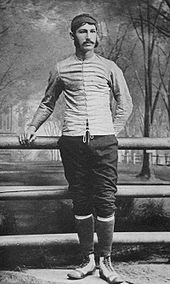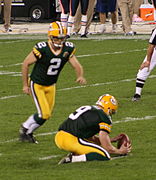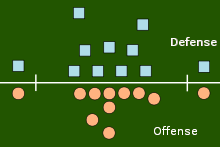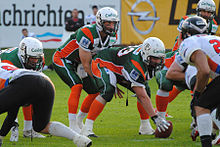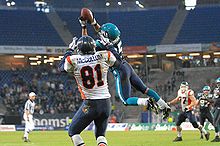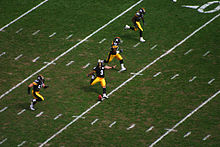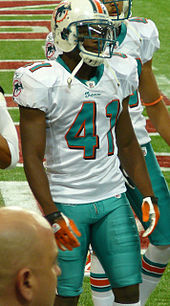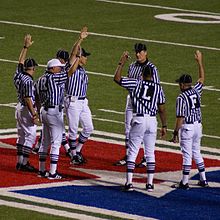
American football
About this schools Wikipedia selection
This content from Wikipedia has been selected by SOS Children for suitability in schools around the world. A quick link for child sponsorship is http://www.sponsor-a-child.org.uk/
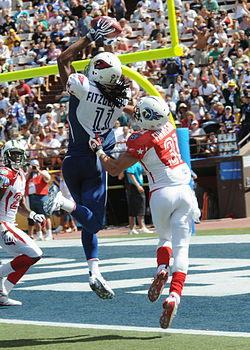 Larry Fitzgerald catches a pass at the 2009 Pro Bowl |
|
| Nickname(s) | Football, gridiron |
|---|---|
| First played | November 6, 1869, Princeton vs. Rutgers |
| Characteristics | |
| Contact | Full-contact |
| Team members | 11 per side Both teams can substitute players freely between downs |
| Categorization | Team sport, ball game |
| Equipment | Football Football helmet Pads ( shoulder and knee) |
| Venue | Football field (or gridiron) |
| Olympic | No; demonstrated at the 1932 Summer Olympics |
American football, known as football in the United States, is a team sport played between two teams of 11 players with an oval ball on a rectangular field 120 yards long and 53.3 yards wide with goalposts at either end. The team in possession of the ball (the offense) attempts to advance down the field by running with or passing the ball. In order to continue their drive, the offense must advance the ball at least 10 yards down the field in a series of four downs. If they succeed, they receive a new set of four downs to continue their drive, but if they fail, they lose control of the ball to the opposing team. The offense can score points by advancing the ball into the end zone (a touchdown) or by place- or drop-kicking the ball through the opponent's goalpost (a field goal), while the defense can score points by forcing an offensive turnover and advancing the ball into the offense's end zone or by tackling the ballcarrier in the offense's end zone (a safety). The team that has scored the most points by the end of the game wins.
American football evolved from early forms of rugby (particularly rugby union) and association football (soccer), with the first game played on November 6, 1869. Rule changes from 1880 on by Walter Camp included the snap, 11-a-side teams and downs; further rule changes legalized the forward pass and created the neutral zone along the width of the football. Today, American football is the most popular sport in the United States, where the National Football League (NFL) is the most popular league. The league's championship, the Super Bowl, is among the most-watched club sporting events in the world.
History
American football evolved from the sport of rugby football. The first football game, played on November 6, 1869 between Rutgers and Princeton, was played with a round ball with 25-men on each team and resembled a combination of rugby and soccer in its rules. After several years of irregular collegiate play with games played under varying rules, the representatives of Yale, Columbia, Princeton and Rutgers met at the Fifth Avenue Hotel in New York on October 19, 1873 to determine a set of rules for all colleges involved to follow. They developed 12 simple rules, establishing (among other things) 20-a-side teams and fields 400 by 250 feet while prohibiting the carrying or throwing of the ball; instead, the ball could be kicked. A notable absence from this conference was Harvard, who disagreed with the prohibition of running with the ball. Harvard gravitated towards rugby and ultimately played Yale in a variation of rugby in 1875. Two Princeton players attended the Harvard-Yale game and were thoroughly impressed with the sport, praising it to fellow students back at their college. In a feat the Professional Football Researchers Association compared to "selling refrigerators to Eskimos", the two players managed to sell the sport to Princeton; Princeton then invited Harvard, Yale and Columbia to a meeting to "sit down and decide to play [rugby] the way Princeton wanted". The group adopted most of the rules of rugby union, but set different rules regarding touchdown scoring by counting four touchdowns as equal to a goal but of lesser value than a goal after touchdown. All of these schools except Yale formed the Intercollegiate Football Association, with Yale eventually joining in 1879. After several rejected suggestions, Yale player Walter Camp (now regarded as the "Father of American Football") succeeded in passing rule changes in 1880 that reduced the teams from 15 to 11 players and instituted the snap to replace the chaotic and inconsistent scrum.
Camp had not expected the snap to result in major strategy changes, assuming teams would run the ball for a few plays before punting. The previous strategy had been to punt the ball if a scrum resulted in bad field position, and Camp assumed this would not change with the snap. However, a group of Princeton players invented a way to prevent opposing teams from scoring; holding the ball indefinitely and wasting time. Princeton used this strategy in the 1881 Princeton-Yale game. Princeton entered the game undefeated, as did Yale, and wanted to keep that record. To that end, they wasted the entire first half by holding the ball and gaining no yardage. Yale utilized this strategy in the second half under the orders of team captain Camp, who feared a miscue could turn the game to Princeton. This game (derided as the "blocking game") was extremely unpopular with fans of both teams, who had paid money to watch the game, and those in charge of the rules realized this exploitation would need to be fixed immediately. Although reverting to the scrum was briefly considered, a rule passed in 1882 by Camp stated that a team would have three downs (tackles) to advance the ball five yards or else they would forfeit control of the ball to the other team. This rule change made American football a separate sport from rugby and the resulting five-yard lines added to the field made it resemble a gridiron in appearance. Other major rules changes included a reduction of the field size to 110 yards long by 53.3 yards wide and the adoption of standardized scoring system that awarded four points for a touchdown, two for a safety and a goal following a touchdown, and five for a goal from field. Tackling below the waist was legalized in 1888, eliminating the last major remnant of rugby. Despite these rule modernizations and innovations, football remained a violent sport —- dangerous mass-formations like the flying wedge resulted in serious injuries or even death for players. The situation reached its peak in 1905 when there were 19 fatalities nationwide, getting to the point where President Theodore Roosevelt threatened to eliminate the game if major changes were not made. To help improve safety, 62 schools met in New York City to discuss rule changes on December 28, 1905. The Intercollegiate Athletic Association of the United States, later named the National Collegiate Athletic Association (NCAA), was formed as a result of the proceedings. The legal forward pass was introduced in 1906 after its suggestion by John Heisman, albeit with a set of restrictions that made it have little impact at the time. Additionally, the time of play was reduced from 70 to 60 minutes and the distance requirement for a first was increased to 10 yards over three downs. Further, the neutral zone was created along the width of the football. In 1914, the roughing-the-passer penalty was implemented for the first time, while the rules were changed to allow eligible players to catch the ball anywhere on the field in 1918. Further, field goals were lowered to three points in 1909 and touchdowns raised to six points in 1912. The field was also reduced to 100 yards long, but two 10-yard-long end zones were created, and teams were given four downs instead of three to advance the ball 10 yards.
Gameplay
American football is played between two teams of 11 players each, with an oval (specifically prolate spheroid) ball. The basic format of the game involves two teams, one of which is in possession of the ball. The team in possession of the ball, termed the offense, tries to advance the ball towards the end zone, the scoring area at either end of the field. The other team, termed the defense, tries to stop the offense and prevent them from advancing the ball. A game begins with a kickoff; the kicking and receiving teams are determined by a pre-game coin toss. The kickoff occurs as a player on the kicking team (the placekicker) kicks the ball from a tee. The receiving team then catches the ball and runs towards the opposing end zone until they are tackled or step out of bounds, at which point the ball is considered dead. The point where the ball becomes dead is defined as the first line of scrimmage, and play begins from that point.
Advancement of the ball occurs as a series of up to four discrete plays or downs. The offense must gain at least 10 yards in the four downs to continue advancing the ball. Before the start of the play, an official places the ball on the field so that the long axis of the ball is parallel to the sidelines. It is placed on or between the two sets of hash marks along the line, parallel to the goal line, where the previous play was declared dead. The two teams line up on either side of the line of scrimmage or "neutral zone", which is defined as the space as wide as the length of the ball extending from sideline to sideline parallel to the goal lines. Neither team may cross this neutral zone before the start of the play. A play begins with the snap, which occurs when the ball is lifted from the ground by one player on the offense (the centre) and passed backwards to a second player (usually the quarterback). Play then continues until the ball becomes dead, at which point the down is considered over. If the player was tackled, steps out of bounds or his forward progress was stopped, the ball is placed at the spot of the tackle or where the player stepped out of bounds. If the ball became dead from an incomplete forward pass, the ball is placed at the same place it was at the start of the prior down. If the play resulted in a first down, a new set of four downs are given to the offense. If the offense does not advance the ball 10 yards in the four plays, they lose control of the ball to the defensive team. Normally, teams attempt either a field goal or choose to punt the ball away to the other team on fourth down, depending on their position on the field, rather than risk losing control of the ball. During the course of play, either team may be charged a penalty for violating various rules of play. An official will indicate that a penalty has occurred by throwing a yellow flag on the ground.
Teams can score points in several ways in football; a touchdown, worth six points, is the primary means of scoring. It occurs when the offense advances the ball into the defense's end zone or when the defense takes control of the ball and, on the same play, advances the ball into the offense's end zone. Following a touchdown, the scoring team attempts to score either one or two points by kicking or advancing the ball into the end zone (known as the extra point and two-point conversion, respectively) from two (NFL) or three (amateur) yards back from the goal line. In practice, the extra point is virtually automatic at the professional level and slightly less so at the amateur level, while the two-point conversion has a significantly lower success rate. Teams can also score by a field goal, which occurs when the offensive placekicks or drop kicks the ball over the crossbar and between the goal posts at the back of the end zone. The offense is awarded three points for a field goal. A safety is scored by the defense when they tackle the ballcarrier in their own end zone. Following an extra point/two-point conversion attempt or successful field goal the scoring team must kick the ball off, while the team that is scored upon must kick the ball off after a safety.
|
Teams and positions
A game is played between two teams of 11 players each; having less players on the field is legal, but playing with more on the field is punishable by a penalty. Teams may substitute any number of their players between downs, and the game in general has developed a system where teams have different offensive, defensive and special teams squads. This system is a vital aspect of the modern game and replaced the old system, where only limited substitution was allowed. Individual players in a football game must be designated with a uniform number which is between 1 and 99; in the NFL, teams are required to number their players by a league-approved numbering system during the regular season and any exceptions must be approved by the Commissioner, while in the NCAA and NFHS teams are "strongly advised" to number their offensive players according to a league-suggested numbering scheme.
Offensive unit
The role of the offensive unit is to advance the ball down the field, with the ultimate goal of scoring a touchdown.
In football, the offensive team must line up in a legal formation before they can snap the ball. An offensive formation is considered illegal if there are more than four players in the backfield or there are less than five players numbered 50-79 on the offensive line; Players can line up in a position whose eligibility is different than their number permits, provided they immediately report the change to the referee, who will inform the defensive team of the change. The player must continue playing in that position until play has been stopped by a timeout, challenge or foul, the two-minute warning, the end of the quarter, a score by either team, a change in possession between the teams, or if the player withdraws for one play. Neither team's players (with the exception of the snapper) are allowed to line up or cross the neutral zone until the ball is snapped. Additionally, interior offensive linemen are not allowed to move until the ball is snapped.
Backs and backfield
The main backfield positions include the quarterback (QB), halfback/tailback (HB/TB) and fullback (FB). The quarterback is the leader of the offense, with either him or the head coach calling the plays. The quarterback typically informs the rest of the offense of the play in the huddle before the team lines up. The quarterback lines up behind the centre and takes the snap before handing the ball off, throwing it or keeping it to run with himself. The primary role of the halfback or tailback is to carry the ball on running plays as well as to serve as a receiver at times, while fullbacks function primarily as blockers. Fullbacks tend to be larger than running backs and are sometimes used as runners in short-yardage situations, but are oftentimes not used in passing situations.
Linemen
The offensive line consists of several players. The leader of the offensive line is the center (C), who lines up in the middle of the line between the guards. The center is responsible for snapping the ball to the quarterback, and for making sure the other linemen are doing their jobs during the play. On either side of the centre are the guards (G), while tackles (T) line up outside the guards.
Receivers
The principal receivers are the wide receivers (WR) and the tight ends (TE). Wide receivers line up on or near the line of scrimmage, split outside of the line. The main goal of the wide receiver is to catch passes thrown by the quarterback. but the wide receiver also plays a role on running plays by blocking defenders or acting like the play is a pass play so as to distract and confuse the defense. Tight ends line up outside the tackles and function as both receivers and blockers.
Defensive unit
The role of the defense is to prevent the offense from scoring by tackling the ball carrier or by forcing turnovers ( interceptions or fumbles).
Defensive line
The defensive line consists of defensive ends (DE) and defensive tackles (DT). Defensive ends line up on the end of the line, while defensive tackles line up on the inside; their primary responsibilities are to stop running plays on the inside and outside, respectively, as well as to pressure the quarterback on passing plays and to occupy the line so that the linebackers can break through.
Linebackers
Linebackers line up behind the defensive line but in front of the defensive backfield. Linebackers are split into middle linebackers (MLB) and outside linebackers (OLB). Linebackers are the defensive leaders, calling the defensive plays and playing hard to lead by example. They play a diverse number of roles such as defending the run, pressuring the quarterback, guarding tight ends and backs in the passing game, and covering slot receivers.
Defensive backfield
The defensive backfield (also known as the secondary) consists of cornerbacks (CB) and safeties (S); safeties are themselves divided into free safeties (FS) and strong safeties (SS). Cornerbacks line up outside the defensive formation and cover wide receivers, while safeties line up between the cornerbacks but farther back in the secondary. The defensive backfield is responsible for stopping the deep pass and the run.
Special teams unit
The role of the special teams unit is to punt or kick the ball.
Field goals and kickoffs
Specific positions for the field goal/PAT unit are the placekicker (K or PK), holder (H) and long snapper (LS). The long snapper's job is to snap the ball back to the holder, who will catch the ball and place it down to the ground (ideally with the laces facing away from the kicker) so that the placekicker can kick the ball. On kickoffs, the kicker placekicks the ball off of a tee; the player on the receiving team who catches the ball is the kickoff returner (KR).
Punts and punt returners
In a punting situation, specific positions include the punter (P), long snapper and gunners. The long snapper snaps the ball directly to the punter, who will then drop the ball and kick it. The gunners line up outside the line and race down the field to tackle the punt returner. The player on the receiving team who catches the ball is the punt returner (PR).
Equipment
American football is a violent game and players wear armor-like padding to protect themselves. At minimum, players wear a protective football helmet, which has a face mask, and a set of shoulder pads, though different leagues may also require additional padding, including thigh pads/guards, knee pads, chest protectors and mouth guards. College and high school play require the use of a mouthguard. Despite these protections, injuries do occur - particularly concerning are head injuries such as concussions. Concussions are often caused by helmet-to-helmet or upper-body contact between opposing players, although the helmets have prevented more serious injuries such as skull fractures.
Rules
The rules of American football vary somewhat from league to league, but each level of the sport has a prominent, national body which determines a unified code of rules for that level of play. The National Football League (NFL) is the highest level of professional football in the United States. The National Collegiate Athletic Association (NCAA), which manages university athletics in the United States for most colleges and universities, maintains the rules for college football, while high school football is overseen by the National Federation of State High School Associations (NFHS). The largest organization for youth football (younger than high school age) is Pop Warner Little Scholars.
Scoring
Scoring can be accomplished in several ways in American football. A touchdown, worth six points, is the most valuable scoring play; a touchdown is scored when the ball is advanced into, caught or collected in the end zone of the opposing team. Following a touchdown, the scoring team has the chance to score more points through a try (more commonly known as the PAT, meaning point(s)-after-touchdown), a single opportunity to score points. The try attempted by the offense from the two-yard or three-yard line (depending on the level of play) is worth one point (called the extra point) if scored by a field goal and two points (called the two-point conversion) if scored by what would normally be a touchdown. If the attempt fails, no extra points are awarded. A field goal, worth three points, is scored when the ball is placekicked or dropkicked through the uprights and over the crossbars of the defense's goalposts. A safety, worth two points, is scored when the ballcarrier is tackled in his own end zone.
Field
Football games are played on a rectangular field measuring 120 yards (109.7 meters) long and 53.3 yards (48.7 meters) wide. Lines are placed along both the ends and sides of the field (known as end lines and side lines, respectively), and goal lines are marked 10 yards outward from each end line. Weighted pylons are placed on the inside corner of the intersections of the goal lines and end lines. White markings on the field serve to identify the length out from the end zone; these lines include inbound lines (or hash marks), short parallel lines which mark off one-yard increments and that are placed along the sidelines as well as either 70 feet, 9 inches or 60 feet out from the sidelines (depending on the level of play), yard lines, continuous lines running from one end of the field to the other, and a one-yard-long line placed at the centre of the two-yard-lines (in professional play) or three-yard-lines (in college play) at both ends of the field. Numerical marks indicating the yard lines in multiples of 10 are placed along both sides of the field.
Goalposts are placed at the centre of the plane of each of the two end lines; the crossbar of these posts (measuring 18 feet, 6 inches or 5.64 meters in professional and college play and 23 feet, 4 inches or 7.1 meters in high school play) is placed 10 feet above the ground, while the uprights on both ends of the crossbar are extended 30 feet (9.1 meters) in professional fields, a minimum of 30 feet in college fields, and a minimum of 10 feet (3.1 meters) in high school fields.Padding is placed around the base of the goal post, and oranged-colored ribbons are normally placed at the tip of both uprights.
Duration and time stoppages
Football games last a total of 60 minutes in professional and college play, divided into two halves of 30 minutes and four quarters of 15 minutes. In high school football, games are 48 minutes in length with two halves of 24 minutes and four quarters of 12 minutes. The two halves are separated by a halftime period, while the first and third quarters are also followed by a short break. Games last longer than their defined length due to play stoppages, with the average NFL game lasting just over 3 hours. Teams switch goals following the first and third quarters. If a down is in progress and a quarter ends, play continues until the down is completed.
Time in a football game is measured by the game clock. An operator is responsible for starting, stopping and generally operating the game clock; the operator does so based on the direction of the appropriate official. A separate clock, the play clock, is used to determine if a delay of game infraction has been committed. If the play clock expires before the ball has been snapped or free-kicked, a delay of game foul is called on the offense. The play clock is set to 40 seconds in professional and college football, and to 25 seconds in high school play or following certain administrative stoppages in the former levels of play.
Advancing the ball and downs
There are two main ways that the offense can advance the ball - running and passing. In a typical play the quarterback calls the play and the centre passes the ball backwards and under his legs to the quarterback (a process known as the snap); the quarterback then either hands the ball off to a back, throws the ball or runs with the ball himself. Once the player with the ball is tackled or goes out of bounds, or a pass hits the ground without a player having caught it, the play is over. A series of four plays, known as downs, are given to the offense. If the offense advances 10 or more yards in the four downs, they are awarded a new set of four downs. If they fail to advance 10 yards, possession of the ball is turned over to the defense. Under most situations, if the offense reaches their fourth down they will punt the ball to the other team, forcing them to begin their drive from further down the field. A group of officials, the chain gang, keep track of both the downs and distance measurements. On television, a yellow line is electronically superimposed on the field to show the first down line to viewing audience. This line does not exist in-person, however.
Kicking
The offensive team can punt, drop kick or place kick the ball on any down from behind or on the line of scrimmage; these are considered to be scrimmage kicks. Out of the scrimmage kicks, only a place kick or a drop kick can be used to score points, but the place kick is the standard method used as it difficult to reliably dropkick a football due to its pointy shape. A punt is generally attempted on fourth down to make the opposing team begin their drive from further down the field.
Once the ball has been kicked from a scrimmage kick, it can only be advanced by the kicking team if it is caught or recovered behind the line of scrimmage; if it is touched or recovered by the kicking team beyond the line, it becomes dead at the spot where it was touched. The kicking team is prohibited from interfering with the receiver's opportunity to catch the ball, and the receiving team has the option of signaling for a fair catch, which prohibits the defense from blocking into or tackling him; however, the play ends as soon as the ball is caught and may not be advanced.
The other type of kick in football is the free kick. Free kicks are the kickoff (which starts the first and third quarters and overtime and follows a try attempt or a successful field goal) and the safety kick (which follows a safety). On a kickoff, the ball is placed at the 35 or 40 yard-line of the kicking team (for professional/college and high school play, respectively). The ball may be drop kicked or place kicked; if a place kick is chosen, the ball can placed on the ground or on a one-inch tee (up to two inches in high school play). A holder can used in either circumstance. On a safety kick, the kicking team kicks the ball from their own 20-yard line; they can punt, drop kick or place kick the ball, but a tee is not allowed to be used in professional play. In either the kickoff or safety kick, the ball may be caught or advanced by any member of the receiving team, and may be recovered by the kicking team once it has gone at least 10 yards or once it has been touched by any member of the receiving team.
Officials and fouls
During a game, officials are responsible for enforcing the rules and monitoring the clock. All officials wear hats (white for the referee and black for the other officials) and black-and-white striped shirts and carry a whistle and weighted yellow flag, the latter of which is thrown to the ground to signal that a penalty has been called. If multiple penalties are spotted by the same official, the official will throw his hat as a secondary signal. There are seven officials on the field, each of which is tasked with a different set of responsibilities:
- The referee is charged with oversight and control of the game and is the authority on the score and down number, as well as any and all rule interpretations in discussions between the other officials. He announces all penalties and discusses the infraction with the offending team's captain, monitors the quarterback to watch for illegal hits, makes requests for the chains to be brought on the field to determine whether a first down has been made, and notifies the head coach whenever a player is ejected.
- The umpire is responsible for determining whether the players' equipment is legal, watching play along the line of scrimmage, making sure that no more than 11 offensive players are on the field prior to the snap, monitoring contact between offensive and defensive lineman (therefore calling most holding penalties), and making sure that the offensive linemen are not illegally downfield on pass plays. The umpire is also in charge of recording the timeouts taken, the winner of the coin toss and the game score, assisting the referee in situations involving possession of the ball close to the line of scrimmage, and drying wet balls prior to the snap if it is raining during a game. The umpire is positioned in the backfield in the NFL.
- The head linesman lines up opposite the line judge. He is charged with watching for any line of scrimmage and illegal use of hands violations and assisting the line judge with illegal shift or illegal motion calls. The head linesman also rules of out-of-bounds calls that happen on his side of the field, oversees the chain crew, grabs the chain on first-down measurements, and normally places his foot on the ground to show the forward progress of a runner on a play that has been whistled dead.
- The line judge is responsible for assisting the other officials and supervising substitutions and the line of scrimmage of punting plays, but is also in charge of supervising the timing during a game. He notifies the referee when time has expired at the end of a quarter and notifies the head coach of the home team when five minutes remain for halftime. In the NFL, the line judge also alerts the referee when two minutes remain in the half. In the event that the clock malfunctions or becomes inoperable, the line judge becomes the timekeeper and keeps track of official time.
- The back judge is responsible for ruling on if the defensive team had more than 11 players on the field, whether catches were legal, and determining if a field goal or extra point attempt was good. He also determines if a pass interference violation was made.
- The side judge performs—for the most part—the same jobs as the back judge, but positions himself 20 yards down the field from the line of scrimmage and opposite the back judge.
- The field judge is responsible for monitoring and controlling the play clock, counting the number of defensive players on the field, watching for pass interference violations and illegal use of the hands violations by offensive players. He is also responsible for passes that go over the defense's goal line and watching fumbled balls in his zone, making decisions regarding catches, recoveries, spotting out of bounds and illegal touching of fumbled balls that have crossed the line of scrimmage.
Another set of officials, the chain crew, are in charge of holding the chains which measure the 10 yards needed for a first down. The chain crew moves the chains up and down the field and keeps track of the current down using the down marker. This system has been used for over 100 years and is considered an accurate measure of distance, rarely subject to criticism from either side.
Leagues and tournaments
In the United States, the National Football League (NFL) and the National Collegiate Athletic Association (NCAA) are the most popular football leagues. The National Football League (NFL) was founded in 1920 and has since become the largest and most popular sport in the United States. Collegiate football (NCAA) ranks third in overall popularity, behind only baseball. The NFL has the highest average attendance of any sporting league in the world, with an average attendance of almost 70,000 persons during the 2011 NFL Season. The championship game of the NFL, the Super Bowl, is among the biggest events in club sports worldwide. It is played between the champions of the National Football Conference (NFC) and the American Football Conference (AFC), with the winner receiving the Vince Lombardi Trophy. The NCAA is divided into three Divisions: Division I, Division II and Division III. Division I football is divided into two football subdivisions: the Football Bowl Subdivision (FBS) and the Football Championship Subdivision (FCS). The champions of Division I-FCS, Division II and Division III are determined through playoff systems, while the Division I-FBS champion is determined through the Bowl Championship Series (BCS); however, Division I-FBS will switch to a four-team playoff system in 2014. Other minor football leagues have been created. The XFL, a minor league created by Vince McMahon, ran for a single season in 2001 before folding. Despite television contracts with NBC and UPN and large expectations, the league suffered from poor on-field play and abysmal television ratings. Another minor league, the United Football League (UFL), has suspended its fourth season in 2012 due to financial issues.
Various other football leagues exist throughout the world. NFL Europe, the developmental league of the National Football league, ran from 1991 to 1992 and then from 1995 to 2007, but was shut down in 2007 after the final World Bowl game. At the time of its closure, NFL Europe had five teams in Germany and one in the Netherlands. European Football League (EFL), run by the European Federation of American Football (EFAF), is an annual invitational tournament between the champions or co-champions of tournaments or competitions run by EFAF federation members. The league's championship game is the Eurobowl. EFAF runs several other tournaments: the EFAF Cup, run between the top European teams in national leagues in a similar manner to the UEFA Cup, the Atlantic Cup, run between teams from the Atlantic region of Europe, and the Challenge Cup, run between teams from newer federations that are not eligible to play in the EFL or EFAF Cup. The International Federation of American Football (IFAF) runs multiple tournaments including the IFAF World Championship, held every four years since 1999. Other tournaments include the IFAF Women's World Championship, IFAF U-19 World Championship and the Flag Football World Championship; IFAF also holds the annual International Bowl.
Canadian football is related to American football with shared roots in rugby football. Although Canadian football developed independently from American football, its rules are similar to American rules. Among other differences, the field is longer and wider (150 by 65 yards as compared to 120 by 53.3 yards) and has 20-yard end zones, there are 12 men per side and only three downs (resulting in a more open, pass-oriented game), and a single point is scored if the ball is kicked out of the defense's end zone by the offensive team. The Canadian Football League (CFL) is the major Canadian league and is the second-most popular sporting league in Canada (behind the National Hockey League).
A major variant of American football is arena football, run by the Arena Football League (AFL). Arena football is eight-on-eight, played on a field 50 yards long (excluding end zones) and 28.3 yards wide. Punting is illegal and kickoffs are attempted from the goal line. A distinctive aspect of the sport is its large rebound nets, which deflect forward passes and kicks. Forward passes that rebound off them are only live until the ball hits the ground, but kicks and missed field goals are live balls for either team. Other rule variations related to pre-snap lineups and motions, rushing the passer and defending the pass are present. Below the Arena Football League are what New York Times writer Mike Tainer described as the "most minor of minor leagues": indoor football leagues. Indoor football leagues such as the Indoor Football League, Southern Indoor Football League, Ultimate Indoor Football League, Continental Indoor Football League and American Professional Football League are unstable, with franchises regularly leaving for other leagues, merging and dissolving.
Flag football is another variation of American football. In flag football, players are not tackled; instead, a play is ruled dead once a "flag" attached the waist of the runner is pulled off. Another variety of American football is touch football, where a play is over when the runner is touched. Depending on the rules used, a game of touch football might be one-hand or two-hand touch.

